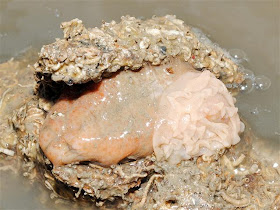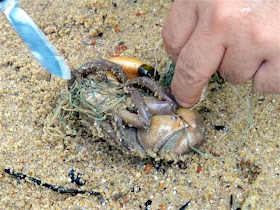What a joy to explore the rocky shores of Changi that is full of rustic charm after many days of absence from the low tide trips this week. I have also not visited this shore for close to two years already.
I was injured (and hurt my old injury again) the whole of last week and thus was stuck at home while the others checked out many shores during the super lows. Being handicapped is really challenging man... Thank God that I am recovering well and therefore managed to "sneak" out of the house with three awesome friends (Ron, James Choi and Yikang) on a Saturday rainy morning.
Though the rain kept most of the marine life away, I was glad to find this Feather star (Order Comatulida) on the rocky shore. Crinoids are quite commonly sighted among the murky shores of Changi.
As like in the past, there are lots of encrusting sponges and ascidians that litter that lower end of the shore zonation.
The different species of sponges that can be found on our northern shores not only are colourful...
But they are also food for our most favourite sea slugs, or also known as the nudibranchs!
The Hypselodoris nudibranch (probably Hypselodoris infucata) are frequently on this shore and it seems to be in season for now! We saw many of them during this trip. However, we did not come across any Hypselodoris kanga which I very much hope to see one day.
There were also several of these Blue-spotted flatworms (cf Pseudoceros indicus) found on rocks and pillars. I also saw one wrapped around the Yellow clustered ascidians (Eudistoma sp.) which could be in the action of eating them.
Many cowries such as this Ovum cowrie (Cypraea ovum) were seen below and above rocks.
Particularly abundant on Changi and some northern shores, the Hoof-shield limpets (Scutus sp.) are not as common found as the cowries elsewhere.
The rock star or the Crown sea star (Asterina coronata) tends to hide underneath rocks or boulders. The mottled coloration blends in quite well with the surrounding.
A pleasant surprise to see two juvenile Estuarine moray eels (Gymnothorax tile) underneath another rock. They were stranded out of water during the low tide period and quickly wiggled their way into the water after the rock was lifted up.
What's a rocky shore with the numerous Stone crabs (Myomenippe hardwicki). They can be sighted at different parts and crevices of the rocky shore.
The only sea urchin type found today will be this Black sea urchin (Temnopleurus toreumaticus).
Like Ria's trip to this shore earlier this week, I also found a coil of nudibranch egg ribbon on the Orange sea cucumber. It's quite interesting to see such an occurence.
The mid-shore was infested with lots of the nest mussels (Musculista senhousia). Some of the usual marine critters settled on top of this layer of mussel bed such as this Swimming anemone (Boloceroides mcmurrichi).
Though the tide was not very low, we managed to catch a glimpse of the Sea fans (Order Gorgonacea) that line the lower edge of the shore.
Not too sure is it because of the rain or longer exposure time out of water due to the week of low spring tides, a couple of the sea fans had parts reduced to its wiry skeletons. Otherwise, most of them were doing fine.
Unfortunately, we also came across several unsightly scenes of how fishing lines or nets have destroyed marine life, such as these uprooted sea fans.
We rescued a poor stone crab suffocating and trapped with the mess of fishing lines. All of our marine life could have escaped from such states if we practice responsible fishing and actions on our shores.
A coastal trip also allows us to have a closer look at the trees and plants growing alongside the shore. However, as usual, I'm not good at appreciating our flora. Haha! It was good learning a little more of these trees from Ron.
Thanks again to the trio for making this trip possible. Nature therapy does help haha. I'll rest and recover completely for the next season of lows! Watch this space for more adventure. :-)
More photos of the trip here: http://www.flickr.com/photos/koksheng/archives/date-taken/2012/06/09/





















No comments:
Post a Comment